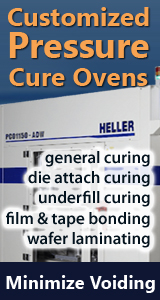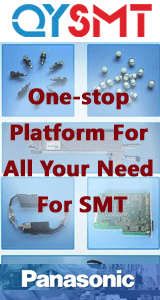Printed Circuit Board Assembly & PCB Design Forum
SMT electronics assembly manufacturing forum.
- SMTnet
- »
- Electronics Forum
- »
- Solder Spotting on Gold
Solder Spotting on Gold
![]()
![]() This text may be of interest to any one with tin lead spot...
- Aug 06, 1998
by
This text may be of interest to any one with tin lead spot...
- Aug 06, 1998
by
![]()
![]() Bob
I have had problems with spotting on gold contacts fo...
- Aug 06, 1998
by
Bob
I have had problems with spotting on gold contacts fo...
- Aug 06, 1998
by
![]()
![]() | Bob
| I have had problems with spotting on gold contact...
- Aug 06, 1998
by
| Bob
| I have had problems with spotting on gold contact...
- Aug 06, 1998
by
![]()
![]() | Bob
| I have had problems with spotting on gold conta...
- Aug 18, 1998
by
| Bob
| I have had problems with spotting on gold conta...
- Aug 18, 1998
by
Bob Willis
Solder Spotting on Gold | 6 August, 1998
This text may be of interest to any one with tin lead spots Guide to Solder Spots - A New Plague in Manufacture ? So what are solder spots ? They appear to be the next big problem in modern reflow assembly in fact in any process that involves solder paste. The spots are visible on the surface of pads after reflow which are not pasted prior to reflow. The spots are seen more commonly on copper, gold or any surface which is not fusible during reflow. The spots are a tin lead alloy which become visible due mainly to the different colour of the pad surface and the wetting action which takes place at reflow. If the spots were on a tin/lead or silver surface there would not be much of a problem. Out of site out of mind. Some companies do apply rigid standards or apply the IPC guidelines very vigorously failing the products at final test or during goods receipt if products are contracted out. If the surface of the pads are to be used for interconnection then any contamination may not be acceptable. Contact strips, LCD interconnection or key pads are examples where solder contamination may cause mechanical connection failure of intermittence. This would have cause be related to the position and the size of the spots. It is however much easier to just reject the products than make a judgment call but that is a costly option. Depending on the cost of the product making it viable the spots cab be removed without any obvious signs. If the spot is high off the surface of the pad concern may be shown on the effect on contact resistance on the switch pads. Any key contact or button contacting the surface may be lifted off the pad by the solder spot which will decrease the surface contact and increase the contact resistance. In most cases the contact resistance tolerance on such actions is wide and less likely to cause a problem. Surface analysis of the solder spots has confirmed that the spots are tin/lead and are most probably caused by solder paste particles. More detailed evaluation would be able to determine the alloy content and separate the hand cored wire, wave soldering alloy or even plating from component terminations. The particles present on the surface of the pads during reflow will wet the surface and it only takes the smallest of particles to have a visual impact on copper and gold features. The surface spots can be seen as a random defect or consistently in the same position on the circuit pattern. They are very commonly seen at the edge of tacks and pads which is normally a fairly good indication of the root cause of the problem. Elimination of the spot plague needs close consideration of each of the assembly stages in the modern factory it is necessary as each could contribute to the problem of surface contaminates. So lets call in the spot inspector ! Screen Print During solder paste printing thousands of small balls are printed on to the surface of the board in an attempt to produce consistent solder joints. During normal printing there are a number of things which make contact with the top and bottom surface of the board. The most obvious is the metal stencil which contacts the surface of the pads and depending on the pressure applied during printing the surface of the board. Solder paste will squeeze out between the stencil and the pad if a poor gasket is produced allowing paste to contaminate the base of the stencil. Recent video recordings produced by the author showing paste squeeze out due to un even board surfaces show how much this can be a problem in manufacture. In this situation the paste particles on the base of the stencil can contaminate the adjacent areas of the next and future boards. When a under stencil wipe is used the particles can be spread around on the base of the stencil without being properly removed resulting in random spots after reflow. Care needs to be taken on the maintenance of the wiper cloth and the solvents used. During printing supports are used to maintain the board flat and provide the ideal surface for printing. The board support may be a solid machined plate, groups of magnetic pins or specially molded supports. In the case of the machined or molded support or nests vacuum is normally used to help nest the board. Excessive suction has been shown to pull paste particles through the board to the base or along the surface of the board between the stencil. In each case this has resulted surface contamination which can be random or in a line from a pasted pad feature to a via or hole where the vacuum pressure is seen. It is also most likely to be on the edge of pads. There are very few examples of plating outgassing today but one example of a surface mount component was analysis recently. The component terminations outgassed during soldering causing voids in the joints and local spots. This was originally blamed on the paste and reflow profile until the components were tested. PCB Wash Off One of the most common reasons for random defects is washed off boards. The board may look clean but a few solder balls is all it take to cause solder spotting. If the a board is poorly printed or these is down time on a production line boards may be washed off. When this is done paste particles can still be found in via holes, tooling holes and in resist apertures between the resist wall and the pad. This is why after reflow solder spotting is often seen at the very edge of the pads. There have been many occasions where poor washing was the cause but every one said the boards had never been cleaned. "We never ever do that" said one contractor at an workshop only to be shown the particles in the solder resist undercut. Placement After components are placed into the surface of the paste the board should be reflowed and that is the operation complete. Misplaced components can be only just off the surface of the pad or completely misplaced. This can result in manual pick up of a part and repositioning it in its correct location. If the part has been in contact with the paste then the terminations will have paste on them. If the part was on another pad which is not pasted some paste will be left behind when the part is lifted. This would be totally random and very few companies have records of the occasional replacement exercise. Reflow Some engineers have blamed the reflow oven for causing the paste to spit resulting in random spotting. Solder paste should not spit during reflow if the profile and the paste are compatible. To test your product simply take a hot plate and a pasted board and reflow the board on the plate matching the profile recommended by the solder paste supplier. This has been done in the past by placing shims between the board and the plate to adjust the ramp rate. The same test can be conducted in an oven during the normal reflow cycle but it does not provide the opportunity to record or observe the cycle, seeing is believing. Take an hour glass plate normally used in a laboratory and place it over the board. The smaller the glass and the closer it is to the paste the better. This technique was originally used by the author to show when the different solvents in a paste evaporated during reflow. Normally condensation is seen on the surface of the If any spitting where to occur with a paste this would be visible on the hour glass. An alternative is to use a white card when placed over a hot plate. The white paper or card trick is also used to asses some cored solder wires for spiting during hand soldering and is simple and cheap evaluation tool. A number of engineers have considered the possibility of paste particles being circulated in the convection reflow oven. Either due to high convection rates or re-circulating of gas at reflow or cooling phases. Poor maintenance of the equipment could it has been suggested allow paste particles to fall onto the surface of passing boards prior to reflow. This is less likely due to the weight of the paste particles but can easily be determined. Production manager may not like it as through put is king but a problem need to be sorted. Take a few sheets of thin copper laminate and without any production running through the machine pass the sheets repeatedly through the process. Inspect the panels after each pass for spotting. There are still some companies who process double sided reflow products on mesh belts with the board in contact with the mesh during it second pass. A poorly maintained machine can easily have paste residues on the mesh which could contaminate the base of the board. A final area to investigate are the entry and zone curtains on some ovens. The rubber curtains can if incorrectly positioned or cut will not only contaminate the board but displace components. Rework If solder paste is used during rework there is an opportunity for paste contamination. Normally paste used during rework is manually dispensed although some companies use mini stencils to apply the paste. This is a more obvious area for paste contamination and would normally be spotted quite quickly during investigation. Finally just handling the boards in production should be avoided as any operator or technician knows paste gets every where. Generally when operators are using bare hands to handle boards they tend to be more careful with paste contamination. Some companies have the policy of wearing gloves which reduces the need for care as the paste will not go on your hands. Disposable gloves are used but they tend to causes sweating and not that well liked. The alternative reusable gloves tend to get dirty and again cause handling contamination. If any one has any other examples of where paste residues appear on non pasted areas of printed boards and then form the solder spot plague then please Email us your causes and cures. This breath introduction can then be updated and circulated again. Bob Willis can be contacted via his Internet Web Page http://www.bobwillis.co.uk or by Email eps@bobwillis.co.uk
Mike
Re: Solder Spotting on Gold | 6 August, 1998
Bob I have had problems with spotting on gold contacts for many years and have spent many hours working on ways to solve this problem. Once a source of the problem is found and corrected the next month another source will crop up (new operator on the screen printer, etc.). We use a system here where we have not had this problem at all. We use Kapton tape and mask all gold contacts prior to introducing the boards to the production floor. This may sound like a Band-Aid but we have not had to rework any gold contacts for several years. Also on another note, regarding your picture, you look like a nice enough of a guy but what is the purpose of placing your picture here. Maybe that space could be better utilized. Mike
Bob Willis
Re: Solder Spotting on Gold | 6 August, 1998
| Bob | I have had problems with spotting on gold contacts for many years and have spent many hours working on ways to solve this problem. Once a source of the problem is found and corrected the next month another source will crop up (new operator on the screen printer, etc.). We use a system here where we have not had this problem at all. We use Kapton tape and mask all gold contacts prior to introducing the boards to the production floor. This may sound like a Band-Aid | but we have not had to rework any gold contacts for several years. | Also on another note, regarding your picture, you look like a nice enough of a guy but what is the purpose of placing your picture here. Maybe that space could be better utilized. | Mike Thanks for the kind comments but all I have to sell is me. The spotting I was refereing to is not just the finger tabs which you have spoken about its the spots on other areas of the board. Having had the same problem as you with the finger problem I think the Kapton tape is fine, it keeps 3M in business !!
Zambri
Re: Solder Spotting on Gold | 18 August, 1998
| Bob | I have had problems with spotting on gold contacts for many years and have spent many hours working on ways to solve this problem. Once a source of the problem is found and corrected the next month another source will crop up (new operator on the screen printer, etc.). We use a system here where we have not had this problem at all. We use Kapton tape and mask all gold contacts prior to introducing the boards to the production floor. This may sound like a Band-Aid | but we have not had to rework any gold contacts for several years. | Also on another note, regarding your picture, you look like a nice enough of a guy but what is the purpose of placing your picture here. Maybe that space could be better utilized. | Mike Hi Mike, There are a few things that need to be ironed up first. 1) the stencil cleanliness 2) Handling of the solder paste itself, or 3) the best solution is try to use the epoxy base solder paste. Hope this helps! cheers..
- SMTnet
- »
- Electronics Forum
- »
- Solder Spotting on Gold
© 1995-2024 SMTnet
Visitors
Members
Become a member now and receive the value and benefits of membership.






